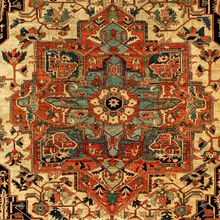Heriz Rug
| Heriz Rug | |
|---|---|
 Design of Heriz Rug (Rugman) | |
| General information | |
| Name | Heriz Rug |
| Original name | قالی هریس |
| Alternative name(s) | Heriz Carpet (Serapi Rug) |
| Origin | |
| Category | Village |
| Technical information | |
| Common designs | Medallion, Geometric |
| Common colors | Red, Brown, Green, Navy Blue, Pink, Blue, Ivory |
| Dyeing method | Natural, Synthetic |
| Pile material | Wool |
| Foundation material | Cotton |
| Knot type | Symmetrical (Turkish) |
Heriz rugs are hand woven in the East Azerbaijan Province of northwestern Iran. Heriz is a very important production center of Persian carpets. Heriz rugs are the most sought after of the tribal rugs. Antique Heriz Persian carpets called Serapi (woven before 1900) are extremely valuable and highly collectable. Most weavers use the Turkish double knot, while the KPSI (knots per square inch) will vary depending upon the quality of the carpet. Heriz Persian carpets from the town's workshops are of better quality than those from the remote mountain villages. The silk Persian carpets are exceptionally finely knotted and are both very rare and absolutely exquisite.
History
Heriz, a town in the East Azerbaijan Province of northwestern Iran, was a famous weaving village during the nineteenth and twentieth centuries. The population is Azeri tribe in origin and speaks a Turkic dialect. Heriz sits at the foot of the Sabalan Mountain and has a cold climate for much of the year.
Heriz rugs and carpets are known in the market from the early nineteenth century. The weavers of Heriz are credited with being the first in Persia to produce room-size and oversize carpets with rustic, nomadic designs. Heriz carpets are well known in the world market and coordinate with the interiors of many European and American homes. They are also in demand for the domestic market, especially in the Azerbaijan Province. Heriz carpets are known to be durable floor coverings. The weavings have a cotton foundation and a wool pile. Heriz weavers also made rugs with a silk foundation and a silk pile. The Turkish (symmetric) knot is always employed.
Heriz carpet designs are geometric, in either a medallion or an allover layout. Some of the designs can be traced back to Anatolian (Turkish) village rug motifs of the seventeenth century. Heriz carpets are best known for having a large center medallion with quartered medallions in the corners of the field. The designs include large stylized palmettes, leaves, and vines, with nomadic motifs and ornaments. Some nineteenth-century Heriz carpets were woven with poetry inscriptions throughout the guard borders. Weaving poems into carpets was popular at the time, but the Heriz inscriptions often cannot be read clearly because village weavers were unable to trans-fer the words properly. In the nineteenth century American carpet dealers used the term serapi for Heriz wool pile carpets because it was similar to the medallion style of the Mexican serape (blanket or shawl).
Many villages surrounding Heriz adopted the popular designs of Heriz in the last quarter of the nineteenth century in response to world market demand. Generally, the weavings of these villages are grouped as Heriz carpets abroad, but each village is known individually by name in the Iranian market. The popular villages include Ahar, Bilverdi, Goravan, Karadja, Mehraban, Sharabian, and Sinsarai. The famous weaving village of Bakshaish also switched to Heriz designs for better marketing pur-poses by the turn of the twentieth century. Although the designs were similar to Heriz, all of these villages possessed easily identifiable characteristics with their chosen motifs, color, and qualities.
in the mid-nineteenth century Heriz weavers began a carpet-making revival in Persia, producing silk weavings for the first time since the Safavid period during the sixteenth and seventeenth cen-turies. The rugs and carpets were made with semi-geometric designs and woven in a very fine grade with the highest-quality silk available at the time. Medallion, allover, or directional Mihrab (prayer arch) styles were the most popular. The designs were woven with delicate palmettes, leaves, and vines; tribal elements; a Lattice pattern featuring pal-mettes and flowers; Tree of Life motifs occasionally including animals and birds, with poetic inscriptions in the borders and mihrab area; and pictorial subjects. The nineteenth-century Heriz silks are a pre-cious art form, exquisite and beautiful. They are rare and in high demand by collectors.
The coloration of nineteenth- and twentieth-century Heriz carpets generally features brick-red, coral-red, dark blues, or ivory in the field and border. In addition, different shades of red, blue, beige, gold, green, rust, cinnamon, brown, camel, and black are used for the design elements and outlines.
The grade quality ranges from good to fine in Heriz (Serapi) carpets of the nineteenth century and medium to good for carpets of the twentieth century. Sizes range from small pillows to large oversize for-mats. Silk rugs were made in formats ranging from small mats to room-sizes; on rare occasions examples up to approximately eighteen feet by twelve feet can be found.[1]
See also
References
- ↑ Moheban, 2015, 229-231
Bibliography
- Abraham Levi Moheban. 2015. The Encyclopedia of Antique Carpets: Twenty-Five Centuries of Weaving. NewYork: Princeton Architectural Press.